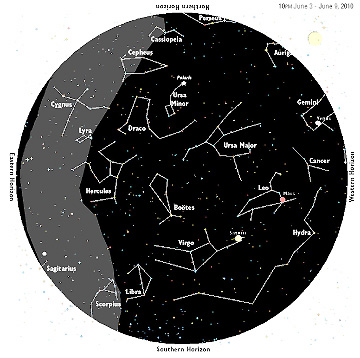Chesapeake Bay's Independent Newspaper ~ Since 1993
1629 Forest Drive, Annapolis, MD 21403 ~ 410-626-9888
Volume xviii, Issue 22 ~ June 3 to June 9, 2010
Home \\ Correspondence \\ from the Editor \\ Submit a Letter \\ Classifieds \\ Contact Us
Best of the Bay \\ Dining Guide \\ Home & Garden Guide \\ Archives \\ Distribution \\ Advertising![]()


Sky Watch

by J. Alex Knoll
Elusive Summer Lights
While binoculars help reveal distant stars and planets, our own galaxy is disappearing before our very eyes
As the sun sets around 8:30 this week, Venus appears in the west, the brightest object visible. Note the difference between Venus and the two first-magnitude stars Castor and Pollux a few degrees above and to the left. Venus sets in the northwest around 11pm, and pretty much sticks to this schedule throughout summer.
Sunset also reveals our other neighbor, Mars, high in the southwest. Mars has been inching to the east, toward the blue star Regulus of Leo the lion. The evening of Sunday the 6th, they pull within one-half degree of one another, fitting within the field of view of binoculars or a small telescope. As a point of reference, the full moon fills one-half degree of sky.
Keep those binoculars handy for another close pairing, as Jupiter and distant Uranus come within one-half degree of one another in the early morning Tuesday, June 8. At magnitude –2, Jupiter is the second-brightest celestial object after Venus. In contrast, Uranus shines at magnitude 6, two thousand times dimmer than Jupiter and straddling the threshold of unaided visibility. But with dark skies and binoculars, you should be able to spot this distant planet. Better still, you have the next several months to get familiar with this distant planet, as remains pegged tight to Jupiter for the next several months.
With the waning moon not rising until well after midnight this week, you may be able to spot one of summer’s great sights, our home galaxy the Milky Way. With clear, dark skies, look overhead for its wide, glowing band, stretching from the tail of Scorpius in the southeast up to M-shaped Cassiopeia high in the northeast. With the spread of light pollution, the Milky Way is the stellar equivalent of an endangered species, forcing us to escape the glare of city lights to appreciate this river of stars.
Illustration: © Copyright 1925 M.C. Escher/Cordon Art-Baarn-Holland; Graphics: © Copyright 2010 Pacific Publishers. Reprinted by permission from the Tidelog graphic almanac. Bound copies of the annual Tidelog for Chesapeake Bay are $14.95 ppd. from Pacific Publishers, Box 480, Bolinas, CA 94924. Phone 415-868-2909. Weather affects tides. This information is believed to be reliable but no guarantee of accuracy is made by Bay Weekly or Pacific Publishers. The actual layout of Tidelog differs from that used in Bay Weekly. Tidelog graphics are repositioned to reflect Bay Weekly’s distribution cycle.Tides are based on National Oceanic and Atmospheric Administration and are positioned to coincide with high and low tides of Tidelog.
© COPYRIGHT 2010 by New Bay Enterprises, Inc. All rights reserved.
